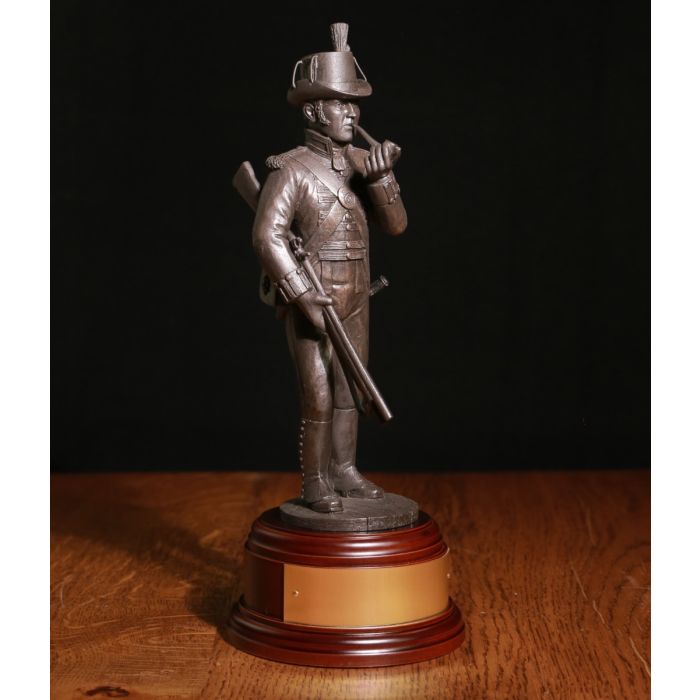- Home
- Sculpture
- Historic
- British Military by Campaign
- Napoleonic Wars
- Royal Marine at Trafalgar 1805
Royal Marine at Trafalgar 1805
This sculpture depicts a marine sharpshooter of 1805, poised to come into the aim, with the intention of shooting down his enemy equivalent, keeping his ship's deck secure to allow seagoing activities to continue.
Royal Marine Sharpshooter
Trafalgar 1805
The Royal Marines were conceived by King Charles II, when at a meeting of the Privy council on the 28th March 1664 directed that “..Twelve Hundred land Souldjers be forthwith raysed, to be in readinesse, to be distributed into his Mats Fleets prepared for Sea Service..”.
Ever since, Royal Navy Marines have always sailed on British Naval Ships and have seen action across the world. By 1793 when the new French Republic declared war on Britain the Marines, although a thoroughly battle tested force, having seen service Spain, Gibraltar, Canada and America, were depleted in number to only 15,000 men.Their first Napoleonic action was fought in France, at the siege of Toulon, where amongst the enemy, Napoleon Bonaparte served as a junior artillery officer.
It was quickly realised that the war, although fought on land, would be strategically won or lost at sea. The Admiralty needed large numbers of sea going soldiers. On a First-rate warship of 100 guns, 170 marines were needed to act, in addition to deck and sailing duties as the Captain of the vessel ordered, as sharpshooters, sentries, boarding parties and gunners. Sea-going marines were often used as crew to sail ‘prize’ ships to British ports, or garrison captured fortresses until relieved.
At the Battle of Trafalgar in 1805, it was just that as Admiral Nelson was shot, he was caught and lowered gently to the ground by Sergeant Secker RM who was one of 2703 Marine officers and men who fought in the battle, 121 of whom lost their lives.
When Britain’s fight to secure the seas was at its height, the Corps of Royal Marines found its true vocation. Raiding, defending and sniping, usually against French Sharpshooters placed high in enemy ship’s rigging, a practise that Nelson despised and banned from the Royal Navy. Members of the Corps learnt to use their initiative attacking across the wooden decks of ‘Men of War’ to capture rather than sink a valuable prize.
The sculpture depicts a marine sharpshooter of 1805, poised to come into the aim, with the intention of shooting down his enemy equivalent, keeping his ship’s deck secure to allow seagoing activities to continue
In an effort to be more sustainable we've had our outer packaging redesigned to be fully recyclable. Every statue comes in a simple elegant printed brown box with printed fabric tape.
Inside the box the statue will be protected with bubble wrap and special foam bags to minimise the chance of damage in transit.

All our statues include an optional engraved plate on the wooden base. On the bronze statues the plate is jewellers brass and the pewter/ silver statues have a nickel silver plate.
To add a plate to your statue please select the option above and enter your engraving details. Please note if the engraving is left blank no plate will be included. If you'd like a blank plate please write this in the engraving details.
Please DOUBLE CHECK the engraving as mistakes will require a new plate to be made.
On the engraving the text will be centred and the font sized to fit the plate.
| Product Code | B77e |
|---|---|
| Price Code | FB |
| Sculpting Scale | 8" |
| Base Material of the Statue | Cold Cast Resin |
| Height Including Presentation Base | 10.75" / 27cm |
| Width with Presentation Base | 4.25" / 11cm |
| Depth with Presentation Base | 4.25" / 11cm |
| Weight | 0.71kg |
Please be aware that these measurements are not exact and have been rounded for ease.
As every item is individually handmade the exact dimensions may vary slighty.
